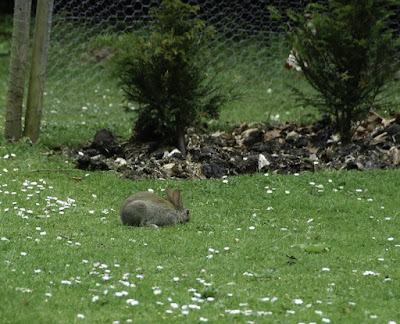An amazing array of gardens and plants
 The songs of birds and diversity of bees are constants in the gardens in Southern England I've been visiting. It's notable, particularly since even though England is a lovely place, it's not unusually species-rich in terms of natives. So gardens, regardless of whatever plants are there, are often quite rich places for harboring an array of wildlife, simply because of the diversity.
The songs of birds and diversity of bees are constants in the gardens in Southern England I've been visiting. It's notable, particularly since even though England is a lovely place, it's not unusually species-rich in terms of natives. So gardens, regardless of whatever plants are there, are often quite rich places for harboring an array of wildlife, simply because of the diversity.A biologist at the University of Sheffield (a fellow whose name escapes me at the moment) wrote a really interesting little book about wildlife in English gardens called something like An Ear to the Ground - basically, his studies had found that diversity of habitats and plants was a key to wildlife diversity in English garden, regardless of origin of plants, and had all sorts of examples of native wildlife using non-native plants.
 Certainly, I can believe that in terms of bees -- there are a LOT of different bees visiting flowers in these gardens.
Certainly, I can believe that in terms of bees -- there are a LOT of different bees visiting flowers in these gardens.The mild climate here means they can grow all sorts of things, and mix up plants in beds in a way that definitely wouldn't work in the Southeastern U.S.
 But what is such fun about gardening here is how fervently it's practiced as a 'hobby'. The nursery/gardens I've visited have been outstanding -- a striking array of plants and unusual species -- also offered for sale, but all arranged and labeled by scientific names, and not common names. It took me awhile to notice this -- at the big public gardens, usually both appear, and I'm accustomed to scientific names.
But what is such fun about gardening here is how fervently it's practiced as a 'hobby'. The nursery/gardens I've visited have been outstanding -- a striking array of plants and unusual species -- also offered for sale, but all arranged and labeled by scientific names, and not common names. It took me awhile to notice this -- at the big public gardens, usually both appear, and I'm accustomed to scientific names.The nursery/gardens that I've visited in the last couple of days -- Iden Croft, Merriment's Garden, and Beth Chatto's Garden -- have had imaginative gardens along with their nursery plants for sale. And all have been packed with visitors and buyers, in spite of what I would consider inclement weather.
 And, they start early. This little boy was fascinated by the bright pink Armeria maritima.
And, they start early. This little boy was fascinated by the bright pink Armeria maritima. But all this diversity takes a LOT of work....
But all this diversity takes a LOT of work....
Comments
Post a Comment
I enjoy hearing from fellow nature lovers and gardeners. Let me know your thoughts.